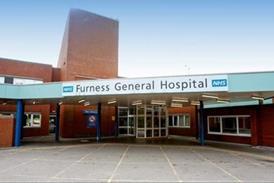With innovation, access, and transformation being the core themes, the NICE Annual Conference will discuss the big challenges facing the health and care sector. By Daloni Carlisle
It’s the annual gathering where policy makers and ministers rub shoulders with staff nurses, consultants and the people running businesses small and large while everyone celebrates the best of health and social care and UK PLC.
That’s one take on the National Institute for Health and Care Excellence Annual conference, which kicks off in May in Liverpool. With a programme running across four streams over two days, there are going to be sessions to suit all areas of interest.
Professor Gillian Leng, deputy chief executive of NICE, explains why the conference programme was compiled around three themes of access, innovation and transformation – and it is very simple. “We listened to our audiences and the feedback was that these are the areas people want us to focus on, so that’s what we are doing,” she says.
Core themes
In NICE’s lexicon “access” is all about getting access to effective new medicines and new technologies and it is an important area not just for patients and clinicians but also for manufacturers, says Professor Leng.
“Innovation is key to developing and changing our health and care services not least so we can use those new drugs and technologies,” she adds. “Healthcare is not static – it never has been. It’s constantly developing and evolving and we have to innovate to deliver it efficiently.”
Innovation is distinct from transformation. “Transformation is about the transformation of services and in 2017, this is particularly about the Sustainability and Transformation Plans which are very topical at the moment. We need to make sure we cover that quite comprehensively.”
These are big ticket items at a time of rapid change and the conference will explore these three important themes. What is the future of the life sciences industry in the UK? What does the new NHS Improvement quality framework mean to you in your workplace? And what are the STPs really all about?
But as students of NICE’s comprehensive portfolio of guidance will know, it’s not just drugs and technologies that concern NICE. Professor Leng will be talking about the workforce and why morale matters.
“It fits in with what NICE is doing in two ways,” she says. “First, there is the guidance that we produce directly for the health service, such as guidance on workforce development and on line management which includes leadership.
“People who come along will get information about what’s going on in the wider health system, ideas about how to achieve transformation in their local area and will go home enthusiastic and energised.”
“Then there is NHS Improvement’s work on building leadership skills and managing talent, Developing People – Improving Care, to which NICE is a partner.”
NICE also contributes to building skills in the NHS, for example with student champions who receive training on how to search NICE Evidence and pass this on to fellow students.
“We run fellowship and scholar programmes and mentor people in training so we contribute in various ways to the leadership agenda and supporting the wider system,” says Professor Leng.
“From a NICE perspective, the evidence is clear that the most effective leaders are inspiring and authentic. and we need to support and encourage them through our guidance and our professional networks.
“As a national body, NICE needs to inspire people to see that new technologies and digital initiatives are really exciting and can help to improve care and make things more efficient for the future.”
Adopting new technologies is not a straightforward task, admits Professor Leng. “But there are some fantastic examples, where leadership is good and staff morale is better and care improves as a result.
”We liaise closely with the Care Quality Commission, and we know there are some great examples rated as outstanding, which also demonstrate good use of NICE guidance.”
Some of these good examples will be on show at the conference in the fourth stream that runs alongside the access, transformation and innovation pillars. This is the reality showcase – proven case studies from the frontline of health and social care.
Guidance and innovation
The final day sees the ever popular shared learning awards, a celebration of NICE guidance in practice in which the audience hears from people who have used guidance in innovative ways and gets a chance to vote for their favourite. It is, says Professor Leng, one of her favourite parts of the conference.
“It’s always exciting seeing people come forward for this,” she says. “It’s great to see how people have come up with ways of using our guidance to really change the care they provide.”
Professor Leng will be chairing the transformation stream and focusing on the STPs. She is keen to highlight the framework NICE has developed over the last year to help local areas deliver their transformation plans.
NICE has a place on the national delivery board as well as most of the regional boards and is engaged both at top level and through its regional field teams.
“We think that our work needs to start pretty much now,” says Professor Leng. “We have reconfigured our field team so that they match the STP regions and they now have a framework to offer advice, support and the ability to connect people working on related initiatives.”
The advice part is intended to feed in at national, regional and local level to help make sure NICE guidance and standards and the evidence base is built into proposals for transformation.
The support section is all about helping local areas identify and implement the relevant standards, guidance and evidence to meet the needs of their population. The connect bit is all about making sure people are in touch with each other and able to share plans and learning.
“Healthcare is not static – it never has been. It’s constantly developing and evolving and we have to innovate to deliver it efficiently.”
“Connecting people at a local level is one of the things that NICE does well,” says Professor Leng. “What people sometimes struggle with is working their way through a maze of advice from NICE and other organisations. Our field teams are expert at tailoring relevant advice to suit local needs.”
So, for example, NICE has been working with the new models of care vanguards in a similar way to the proposed STP support. In Sutton, the NICE field team helped the local care home vanguard identify relevant guidance on transition between care home and hospital.
“The vanguard staff came up with a red bag scheme that uses our guidance in a practical way,” says Professor Leng. “Any patient transferring from a care home to hospital takes with them a red bag that contains all their medical information, their medication and practical things like glasses and teeth. The ambulance crews know about it, as does the local hospital that updates the bag contents on discharge. It has taken four days off the average hospital admission from the care home.”
Professor Leng will obviously be one of the lynch pins of the conference but she is keen to take in some of the speakers too.
“There is a whole host of exciting speakers,” she says. She’s keen, for example, to hear what Lord O’Shaughnessy, the newly appointed health minister and former adviser to David Cameron, has to say.
“I haven’t yet met him,” she says. “I’m really keen to hear what he has to say about how NICE fits into the whole health and care system and his thoughts for the future.”
She is also looking forward to hearing from Sir Hugh Taylor, the independent chair of the Accelerated Access Review. Says Professor Leng: ”I will be keen to hear his views on access and what needs to change. Thoughts are still emerging about how we get things out to the system more quickly.”
And finally, she singles out Helen Stokes-Lampard, the newly appointed chair of the Royal College of General Practitioners and therefore representing an important audience for NICE guidance and advice.
So if you are thinking about coming to the conference, take a look at the programme and see what’s on offer. As Professor Leng says: “People who come along will get information about what’s going on in the wider health system, ideas about how to achieve transformation in their local area and will go home enthusiastic and energised.”
Click here for more details of the event: https://www.niceconference.org.uk/
Six reasons to attend the NICE Annual Conference 2017 - Be Inspired, Ask, Gain, Share, Learn, keep current
Be Inspired by the UK’s leading movers and shakers, as well as by patients and practitioners. Thought-provoking, engaging and challenging speakers from across health, social care and industry.
Ask NICE’s Field Team any burning questions you have during their Q&A and clinics throughout the conference. This is your opportunity to discuss any issues you’re having with NICE guidance – from challenges around implementation to local obstacles, these sessions will be invaluable.
Gain critical insight into patient-centred care, and how to utilise integrated care pathways to improve quality of care for patients.
Share at our Shared Learning Awards! In this extended session hear about best practice examples from across the country, and how colleagues are using NICE guidance and quality standards to improve care.
Learn from projects that demonstrate the use of NICE guidance and quality standards. These sessions focus on the struggles and challenges that had to be negotiated to achieve the best outcome.
Keep current, and find out more about the AAR and changes to NICE’s technology assessment programmes.




























No comments yet